An Epicurean Adventure to the UK: Mastering the Classic Sticky Jamaican Ginger Cake
Embark on a delightful culinary journey to the heart of British baking with this incredibly easy-to-make Jamaican ginger cake. A true testament to comfort food, this cake boasts a rich, dark, and wonderfully moist texture, infused with warming spices that only deepen and meld beautifully with time. It’s more than just a dessert; it’s an experience that offers a hug in every bite, perfect for any occasion.
Despite its evocative name, the Jamaican Ginger Cake, a beloved British classic, did not originate in Jamaica itself. Its captivating story traces back to a pivotal era when Jamaica emerged as one of the primary suppliers of ginger to Britain. Initially, ginger was highly valued for its medicinal properties, particularly its ability to soothe various stomach ailments. However, as the spice became more widely available, its exquisite flavor profile was discovered and celebrated.
This culinary evolution coincided with Jamaica’s role in exporting a bountiful array of warm spices and luscious dark brown sugar. These coveted ingredients soon found their way into British kitchens, inspiring bakers to experiment and innovate. The culmination of this exchange was the birth of the “Jamaican Ginger Cake” – a recipe that ingeniously combined the aromatic warmth of ginger with the rich sweetness of Caribbean-inspired sugars and spices.
Over the years, this beloved cake has acquired several affectionate aliases, including “Jamaican Sticky Ginger Cake,” “Dark Jamaican Gingerbread,” and “Jamaican Ginger Loaf.” Its widespread popularity was significantly boosted by McVitie’s, a renowned British biscuit and cake manufacturer, which introduced its own version to households across the UK, solidifying its status as a national favorite. The true magic of this cake lies in its harmonious blend of traditional comforting flavors: the fiery kick of ginger, the subtle warmth of cinnamon, the fragrant notes of nutmeg and cloves, and the deep, complex sweetness of dark brown sugar and rich black treacle.
Ready to bake this ultimate British classic? Follow our straightforward step-by-step instructions, complete with helpful visual guidance, and treat your loved ones to a truly unforgettable homemade delight.

Fast Facts – United Kingdom

| Location | The United Kingdom (UK) is situated in North-western Europe, comprising four constituent countries: England, Scotland, Wales, and Northern Ireland. Its island geography has profoundly shaped its history, culture, and cuisine, including the beloved Jamaican Ginger Cake. |
| Capital | London. A vibrant global city, London serves as the political, economic, and cultural heart of the UK, influencing trends and traditions across the nation. |
| Language | Beyond English and Welsh, the United Kingdom boasts a rich tapestry of linguistic diversity, with twelve other indigenous languages spoken, including Gaelic, Cornish, Manx, Scots, and three distinct sign languages. While English remains the most widely spoken language, Cornish stands as one of the least commonly used, reflecting the UK’s varied cultural heritage. |
| Population | Circa 66.8 million people. This diverse population contributes to a rich culinary landscape, embracing both traditional British fare and international influences. |
| Trivia | An intriguing study conducted in the UK revealed that cows might share more with humans than previously imagined. Language specialists embarked on this fascinating research after dairy farmers noticed a peculiar phenomenon: their cows seemed to possess regional accents! Much like humans, these bovine inhabitants from various herds appeared to express themselves with subtly different “moos,” adding a whimsical layer to the country’s unique characteristics. |
Why You’ll Adore This Jamaican Ginger Cake Recipe
This recipe for Jamaican Ginger Cake isn’t just another dessert; it’s a culinary gem packed with irresistible qualities that make it a standout. Here’s why this cake is bound to become a staple in your baking repertoire:
- Improves with Time: Unlike many cakes that are best enjoyed fresh, this ginger cake truly flourishes as it ages. The deep, complex flavors of ginger, treacle, and spices meld and intensify over a day or two, making it even more delicious on the second or third day. This quality makes it perfect for preparing in advance for special occasions or simply to enjoy throughout the week.
- Effortlessly Easy to Make: Forget complicated techniques and endless steps. This recipe is designed with simplicity in mind. With clear, easy-to-follow instructions and visual cues, even novice bakers can achieve a perfectly moist and flavorful cake, building confidence in the kitchen.
- The Ultimate Last-Minute Holiday Treat: When time is of the essence, especially during the bustling holiday season, this ginger cake serves as a fantastic alternative to traditional Christmas cakes. Its rich, festive flavors are undeniably seasonal, yet its minimal preparation time means less stress and more enjoyment.
- Travels Exceptionally Well: Planning a potluck, picnic, or a visit to friends? This cake is your ideal companion. Its dense, moist texture ensures it holds up beautifully during transport, arriving in pristine condition, ready to be devoured.
- Incredibly Versatile: Enjoy a slice in countless ways. It’s magnificent as a decadent dessert, a comforting afternoon snack with a cup of tea or coffee, or even a delightful breakfast treat. Pair it with various toppings for different experiences.
- Harmonious Blend of Comforting Spices: The star of this cake is its aromatic spice blend. Warming ginger takes center stage, complemented by cinnamon, nutmeg, and allspice. These carefully chosen spices combine to create an invitingly warm and fragrant cake that evokes feelings of coziness and nostalgia.
- Easy to Customize: While delicious on its own, this cake is also a fantastic canvas for your creativity. Feel free to add chopped nuts like walnuts or pecans for extra crunch, or dried fruits such as raisins or chopped dates for bursts of fruity sweetness.
- Superior Flavor Profile: While popular, commercially produced ginger cakes, like McVitie’s, are pleasant, this homemade version offers a significantly more substantial and nuanced flavor experience. The depth of the dark sugars and generous spice blend creates a richness that simply cannot be replicated by mass-produced alternatives.
Key Ingredient Notes and Essential Substitutions
Achieving the perfect sticky, moist, and spicy Jamaican Ginger Cake hinges on understanding the role of each ingredient. Below are important notes and substitution advice to ensure your baking success. For the complete list of ingredients and precise measurements, please refer to the detailed recipe card at the end of this post.
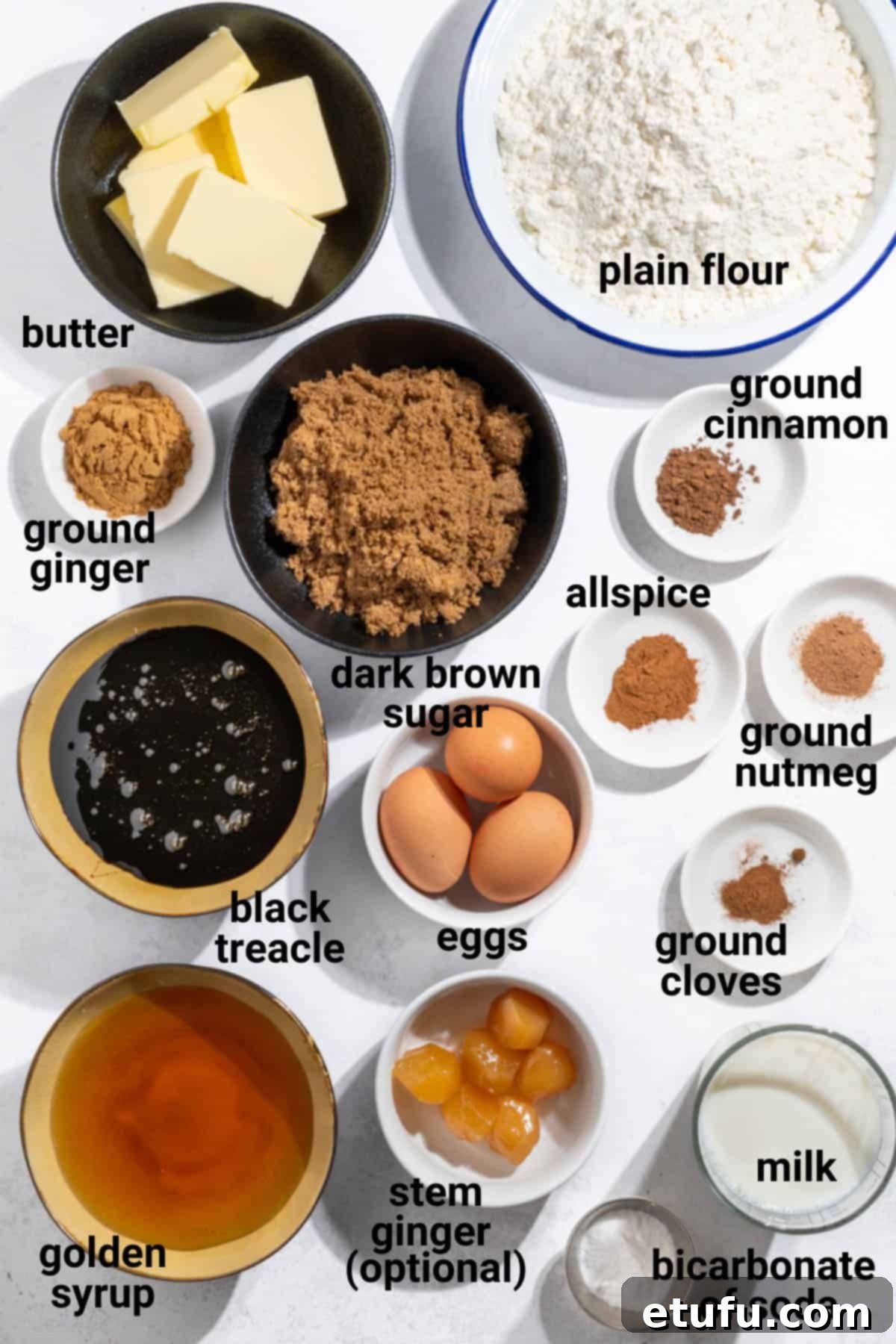
Ginger: The Heart of the Cake
This recipe calls for a generous two and a half tablespoons of ground ginger – yes, that’s a significant amount, but it’s essential for the cake’s signature warming spice. If you prefer an even more intense ginger flavor, you can confidently increase it to three tablespoons. The quality of your ground ginger will greatly impact the final taste, so opt for a fresh, aromatic brand. It’s always a good idea to check your spice cabinet to ensure you have enough ginger before starting your baking adventure!
Butter: For Richness and Moisture
You have the flexibility to use either salted or unsalted butter in this recipe. If you choose unsalted butter, adding half a teaspoon of fine salt to your dry flour mixture is recommended. Salt plays a crucial role in enhancing the overall flavor profile of baked goods, balancing the sweetness and intensifying the spices. While not strictly necessary for the cake’s structure, it certainly elevates the taste.
Golden Syrup: The Golden Touch of Sweetness
Golden syrup, a distinctly British ingredient, is now widely accessible in many countries. According to culinary authority Martha Stewart, most US supermarkets now stock it, which should make your search easier. Lyle’s Golden Syrup is the most iconic and beloved brand in the UK and globally, known for its distinct buttery caramel notes. However, numerous supermarket own-brands offer slightly more economical alternatives that perform just as beautifully in baking, especially when a larger quantity is required. It is crucial NOT to substitute golden syrup with maple syrup or honey, as their flavor profiles and consistencies are vastly different and will alter the cake’s signature texture and taste.
Black Treacle: Deep Color and Complex Flavor
Black treacle is a thick, intensely dark syrup, a byproduct of the sugar refining process. It is a cornerstone ingredient in this Jamaican Ginger Cake, imparting profound moisture and a rich, bittersweet complexity that cannot be replicated by other sweeteners. Its robust flavor is also a common feature in traditional British fruit cakes. You can typically find black treacle in the baking aisle of most major supermarkets. In the UK, it is often produced by the same manufacturers as Lyle’s Golden Syrup and is instantly recognizable by its distinctive red and gold tin.
Dark Brown Sugar: For That Signature Stickiness
Dark brown sugar is essential for achieving the cake’s characteristic dark color, deep caramel notes, and wonderfully sticky texture. You can also use dark muscovado sugar, which offers an even richer, more molasses-like flavor. It is important to avoid substituting with light brown sugar or white sugar, as these lack the depth of flavor and moisture content necessary for this particular cake.
Optional Stem Ginger: A Burst of Fresh Spice
Incorporating stem ginger into this recipe is entirely optional, but it comes with a *highly* enthusiastic recommendation! Stem ginger adds delightful bursts of chewy, spicy sweetness throughout the cake, elevating its flavor to another level. You’ll typically find stem ginger preserved in sugar syrup in jars within the baking aisle. Opies is a popular and reputable brand in the UK. For adventurous bakers, making your own stem ginger from scratch is a rewarding endeavor; an excellent recipe can be found at “Tales from the Kitchen Shed.” Remember to finely chop the stem ginger and toss it in a little flour before adding it to the batter to minimize sinking, as detailed in our Top Tips section.
Essential Equipment for Baking Success
Having the right tools at hand will make your Jamaican Ginger Cake baking experience smooth and enjoyable. Here’s a list of the key equipment you’ll need:
- A Balloon Whisk and an Electric Hand Whisk (optional but recommended): A balloon whisk is perfect for sifting dry ingredients and initially combining the wet mixture. An electric hand whisk, while optional, makes quick work of thoroughly combining the batter, ensuring a smooth and consistent texture without overmixing.
- A Couple of Mixing Bowls: You’ll need at least two: one large bowl for your dry ingredients and another, medium-sized bowl for whisking eggs. Having separate bowls helps in organizing your prep and ensures ingredients are properly combined before mixing.
- A Medium-Large Saucepan: This will be used to gently melt the butter, sugars, and syrups together. A saucepan of adequate size prevents overflow and allows for even heating over a low flame.
- A Rectangular Baking Tin (approx. 33cm x 23cm): This is a standard traybake size in the UK and is ideal for achieving the desired thickness for your ginger cake.
- Note on Tin Size: A larger tin will result in a thinner cake and may require a slight reduction in baking time. Conversely, a slightly smaller tin will yield a thicker cake, potentially needing a few extra minutes in the oven. It’s crucial not to use a tin significantly smaller than 33cm x 23cm, as the generous amount of batter might overflow during baking. Always ensure your chosen tin has sufficient capacity.
A Simple Guide: How to Neatly Line a Rectangular Baking Tin
Properly lining your baking tin is a fundamental step to ensure your Jamaican Ginger Cake releases perfectly without sticking. Follow these easy steps for a professional finish:
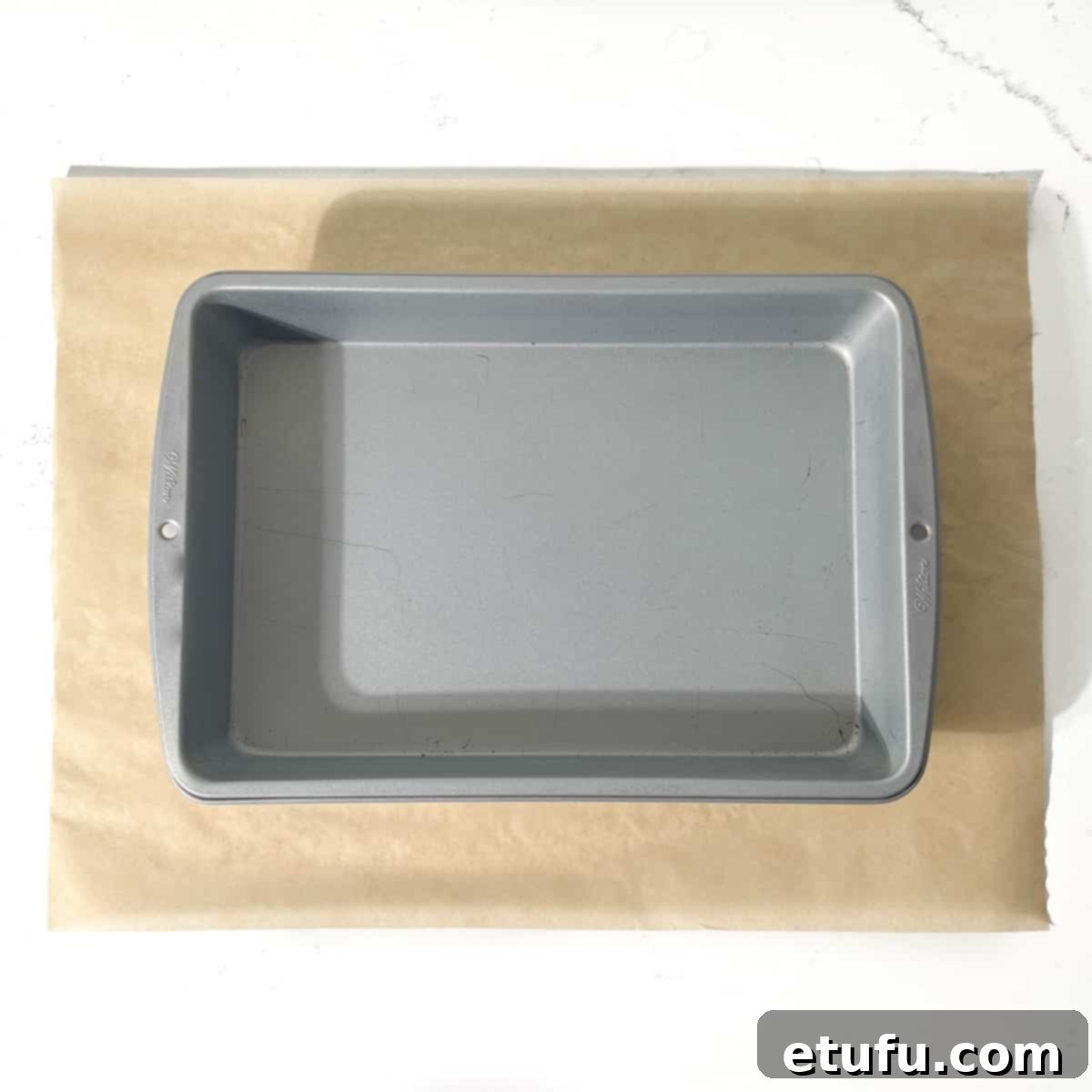
- Start by placing your rectangular baking tin directly onto a large sheet of baking paper. Using a pair of scissors, cut around the base of the tin, leaving a generous border of approximately 8-10cm on all sides. This extra paper will form the sides of your lining.
- Next, to eliminate any unnecessary bulk once the tin is lined, cut off the four corners of the baking paper. Aim to leave about 4cm of paper between the edge of your paper and where the corner of the tray would meet the paper. This creates four distinct flaps.
- For a seamless fit, make a diagonal slit at each of the four corners you previously cut, ensuring the cut is perpendicular to the paper’s edge. Extend this slit right up to where the corner of the tray would sit (as illustrated in the image above). This allows the paper to fold neatly.
- Remove the baking tin from the paper. Now, carefully fold the paper along the lines where the tin’s base and sides would meet. Fold each side inwards towards the center, matching the depth of the cuts you made in the previous step (as shown above). These folds will pre-shape the paper to perfectly fit the tin.
- Gently lower the pre-folded baking paper into the tin. Press it firmly into the corners and along the sides. Thanks to your precise folds, it should now fit snugly and perfectly within the tin, creating a smooth lining for your cake batter.
- Finally, neatly overlap the corners of the baking paper as shown in the picture above. This overlapping technique helps to secure the lining and ensures no batter can seep underneath, preventing sticking and making for easier removal after baking.
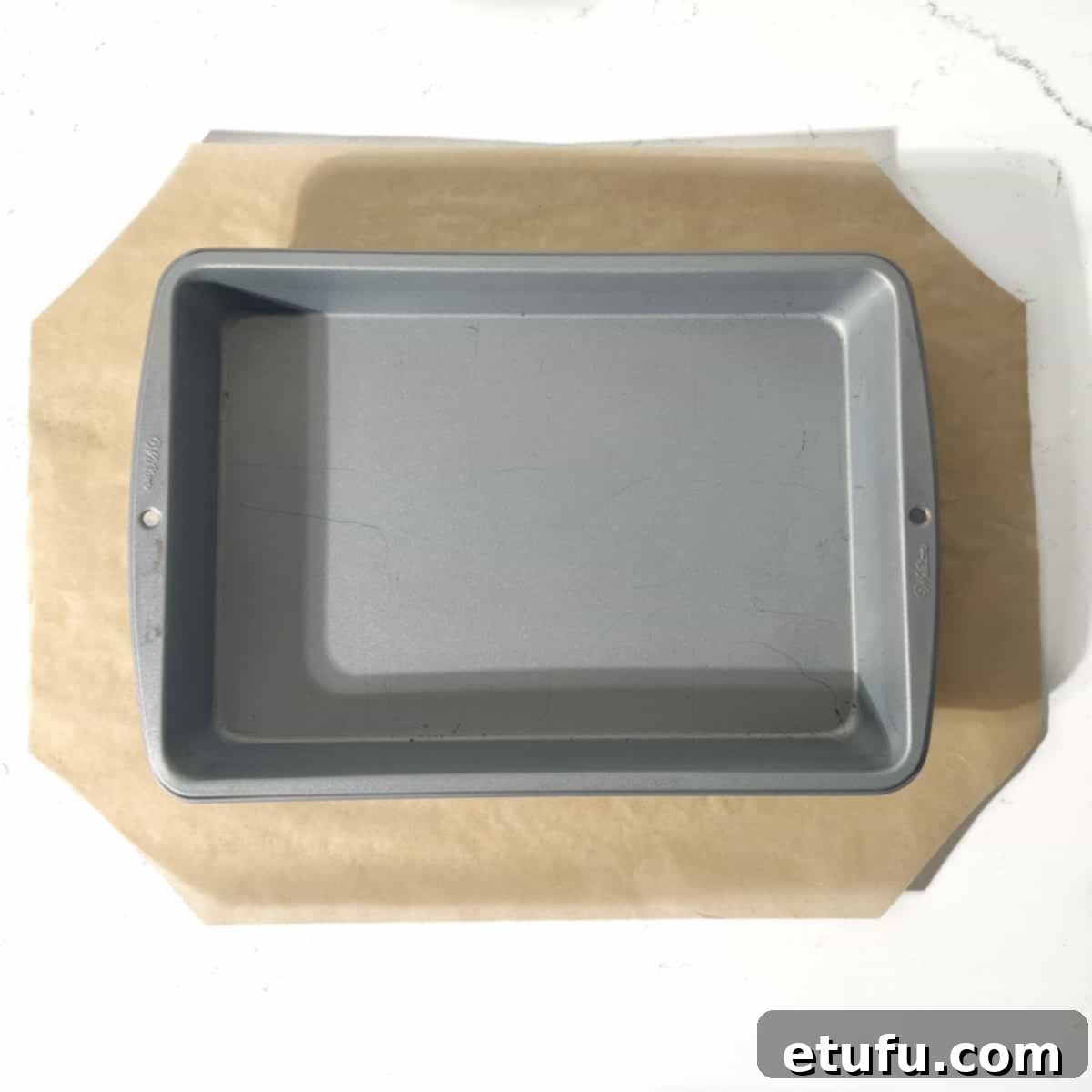
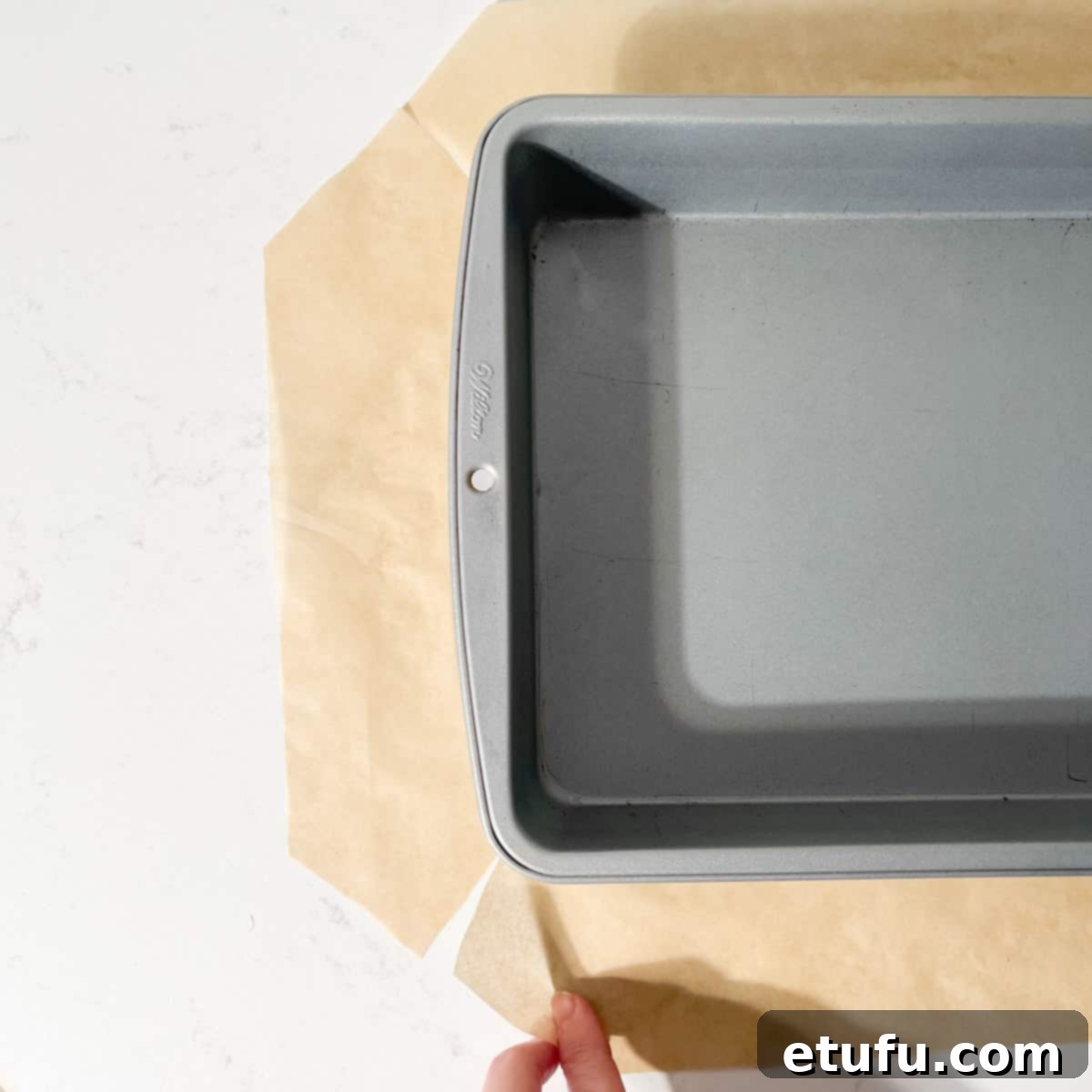
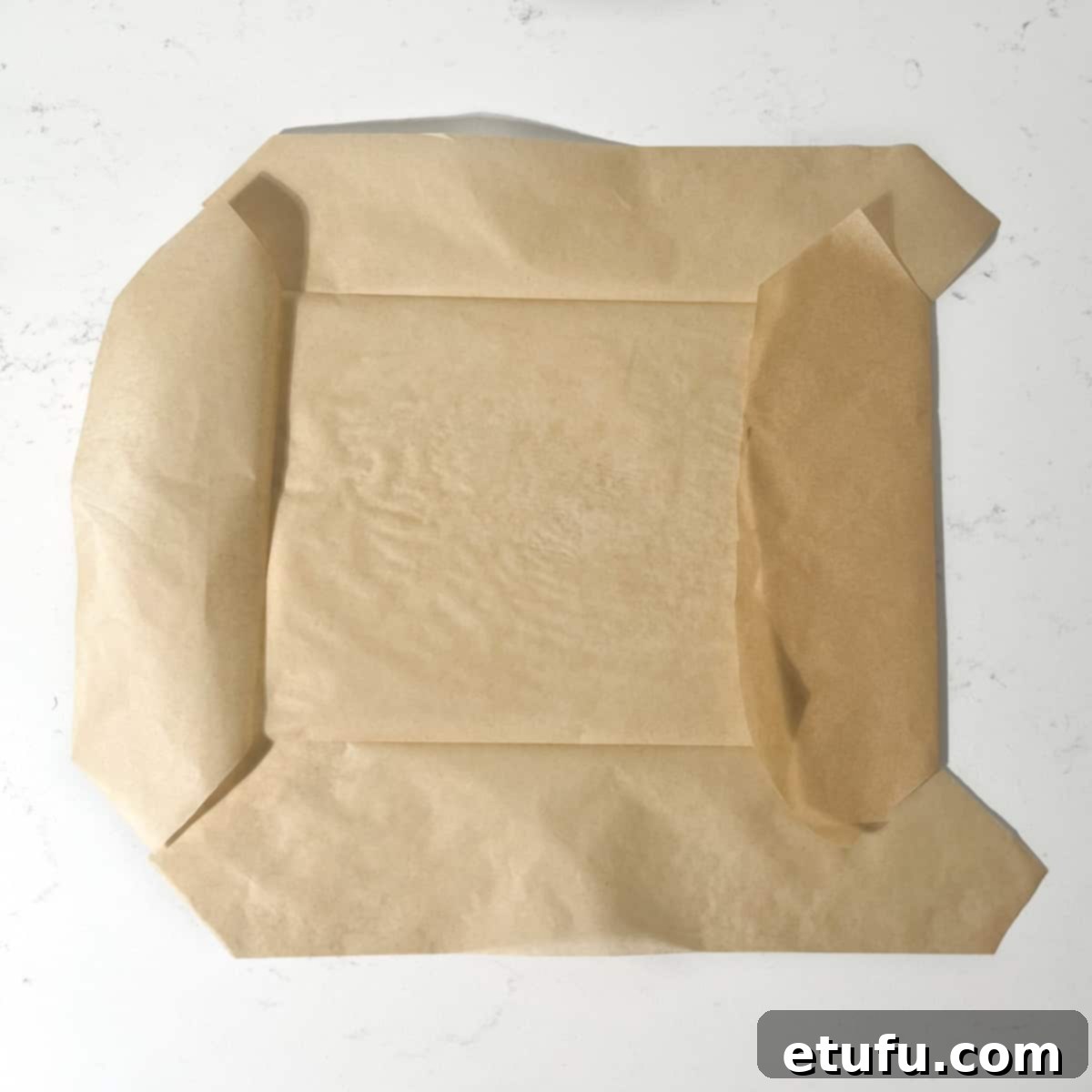
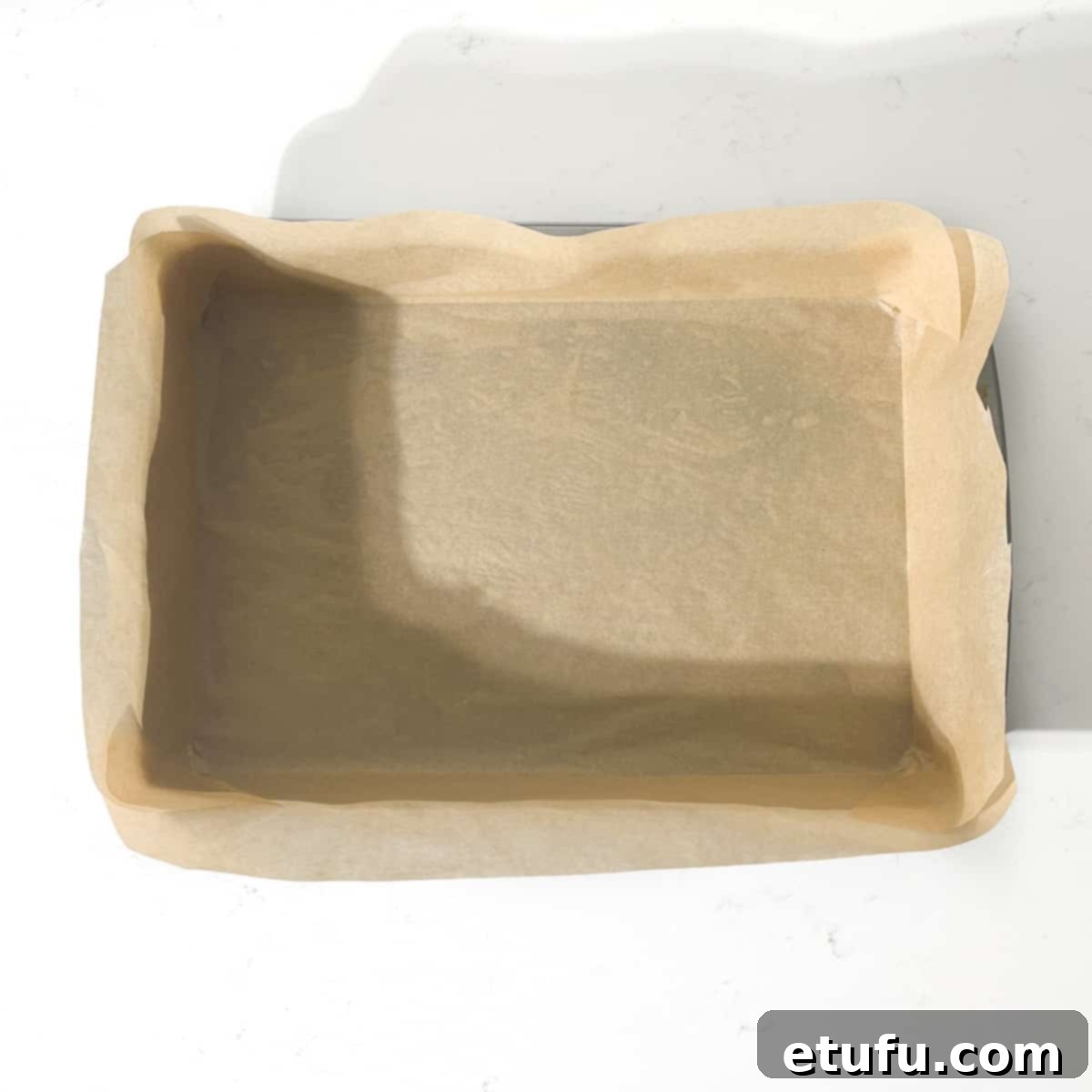

Step-by-Step Guide to Baking Your Jamaican Ginger Cake
Phase 1: Prepping Your Ingredients and Oven
- Begin by preheating your oven to the precise temperature of 170°C (338°F / Gas Mark 3). While the oven warms up, carefully line a rectangular baking tin, approximately 33cm x 23cm, with baking paper using the method described above.
- If you’ve opted to enhance your cake with optional stem ginger, now is the time to prepare it. Using a sharp knife, finely chop the stem ginger into very small pieces. Set these aside; they will be incorporated later.
- In a large mixing bowl, sieve together the plain flour, ground ginger, ground cinnamon, allspice, ground nutmeg, and ground cloves. Sifting ensures that your dry ingredients are well combined and lump-free, contributing to a smooth batter.
- Crack the eggs into a separate, smaller bowl and give them a quick whisk with a fork or small whisk. This breaks up the yolks and whites, ensuring they incorporate smoothly into the batter later.
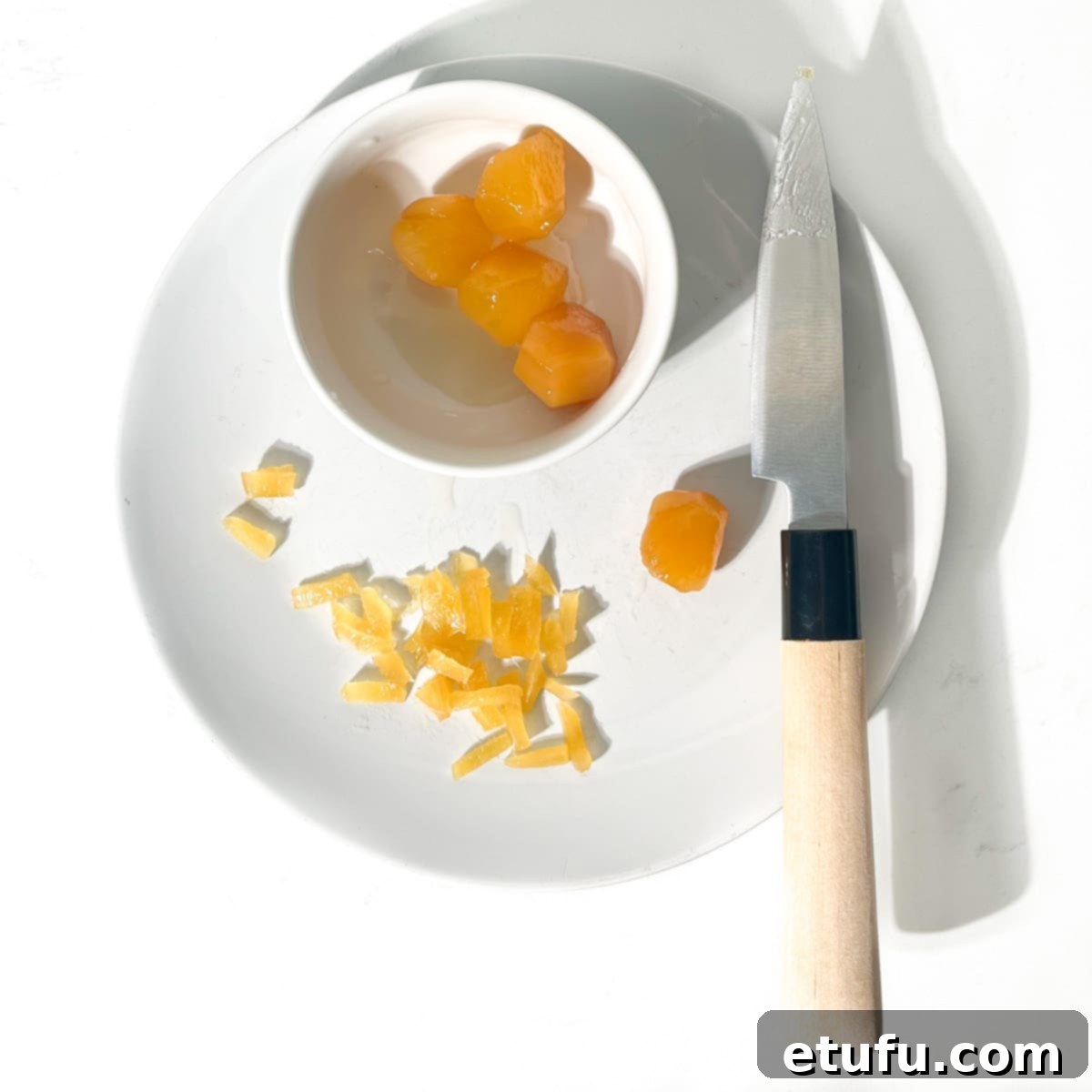
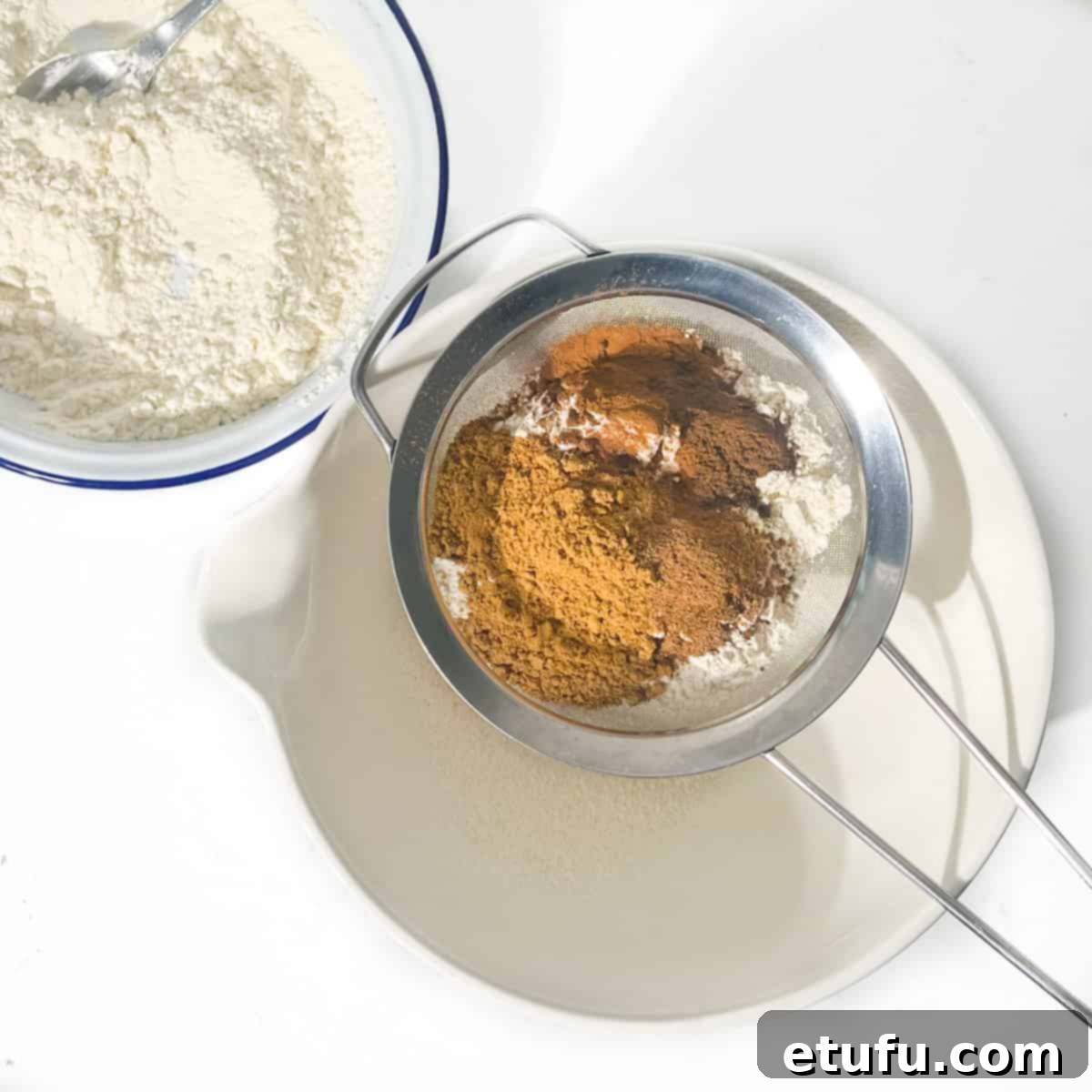

Phase 2: Crafting the Irresistible Cake Batter
- Combine the butter, dark brown sugar, golden syrup, and black treacle in your medium-large saucepan.
- Place the saucepan over a gentle, low heat. Stir continuously until all the ingredients have melted together into a smooth, cohesive mixture. The goal is simply to melt the butter and dissolve the sugars; avoid bringing the mixture to a boil. Remove from heat once melted.
- To temper the warm syrup mixture, pour in the milk first while whisking continuously. This helps to cool the mixture slightly before adding the eggs. Next, incorporate the whisked eggs and sprinkle the bicarbonate of soda evenly over the surface as you whisk vigorously. This even distribution prevents clumping and ensures proper leavening.
- Continue to thoroughly whisk the entire mixture until all ingredients are fully combined and the mixture is smooth and uniform.
- Gradually pour the wet ingredients from the saucepan into the large bowl containing your sieved dry ingredients. Mix thoroughly after each addition. Continue until all the wet ingredients have been incorporated, resulting in a smooth, somewhat wet, and pourable batter.
- Give the batter a final whisk using either an electric hand mixer on medium speed for about 30 seconds, or vigorously by hand for a minute or two. If you are using finely chopped stem ginger, gently fold it into the batter at this stage.
Please note: Even with careful preparation (like coating in flour), stem ginger pieces may still sink somewhat to the bottom of this wet cake batter. Rest assured, it remains a delicious and highly recommended addition, adding wonderful texture and flavor.
- Pour the prepared batter evenly into your lined baking tin. Carefully place the tin on the middle shelf of your preheated oven. Bake for approximately 50-55 minutes. The cake is done when it begins to pull away slightly from the sides of the tin, and the center feels firm yet springy to the touch when gently pressed.
**Important Baking Note: Due to the high content of dark sugars and treacle, this cake will naturally bake to a much darker color than a typical sponge cake. Do not mistake its deep hue for being overbaked; rely on the firmness and springiness of the center.
- Once baked, remove the cake from the oven and allow it to cool in its baking tin for a full 30 minutes. This crucial resting period helps the cake to firm up and prevents it from breaking when transferred. After 30 minutes, carefully turn it out onto a wire rack to cool completely.
- Once cooled, slice the cake into generous squares. Arrange them on a serving plate and savor each comforting bite, perhaps alongside a robust cup of coffee or your favorite tea.
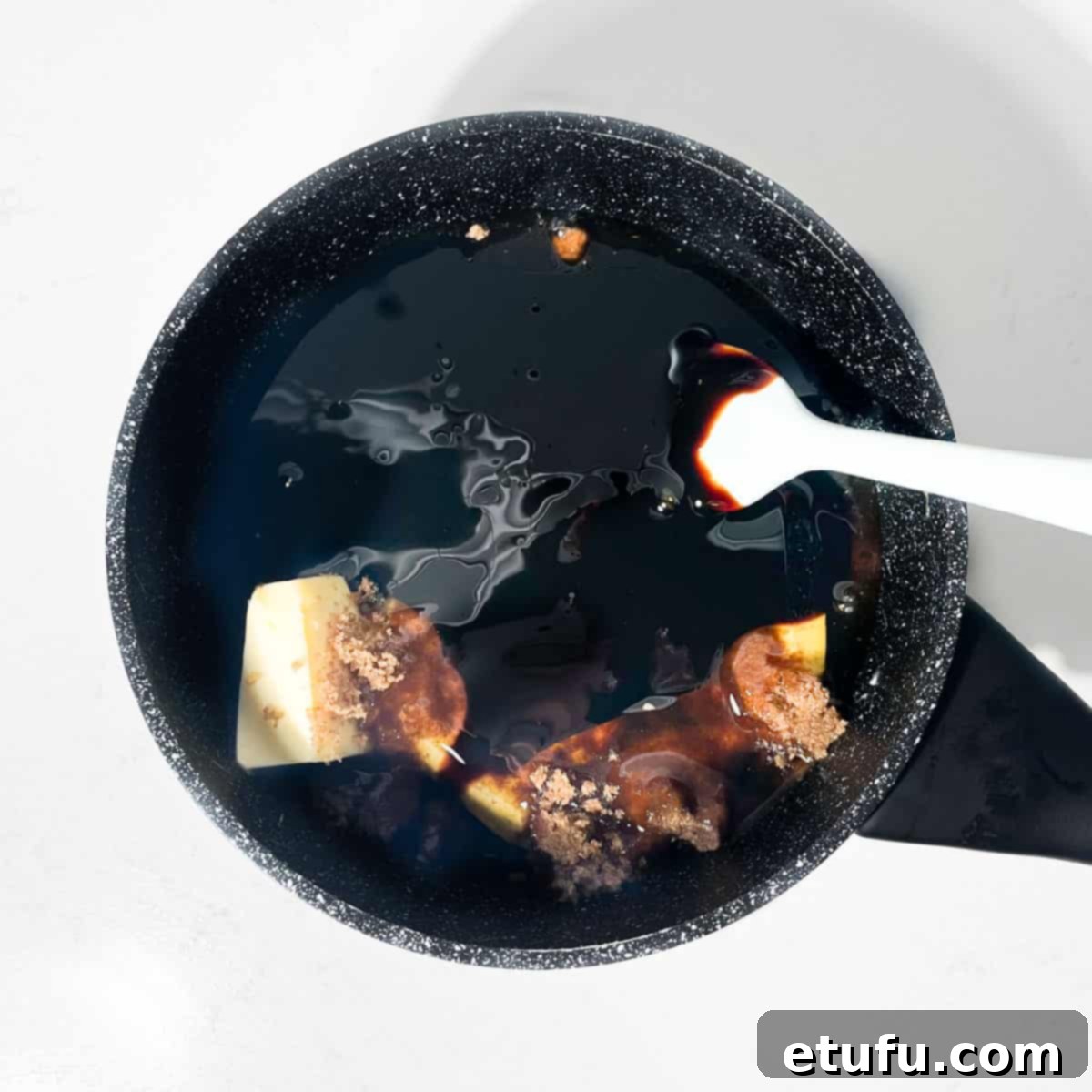

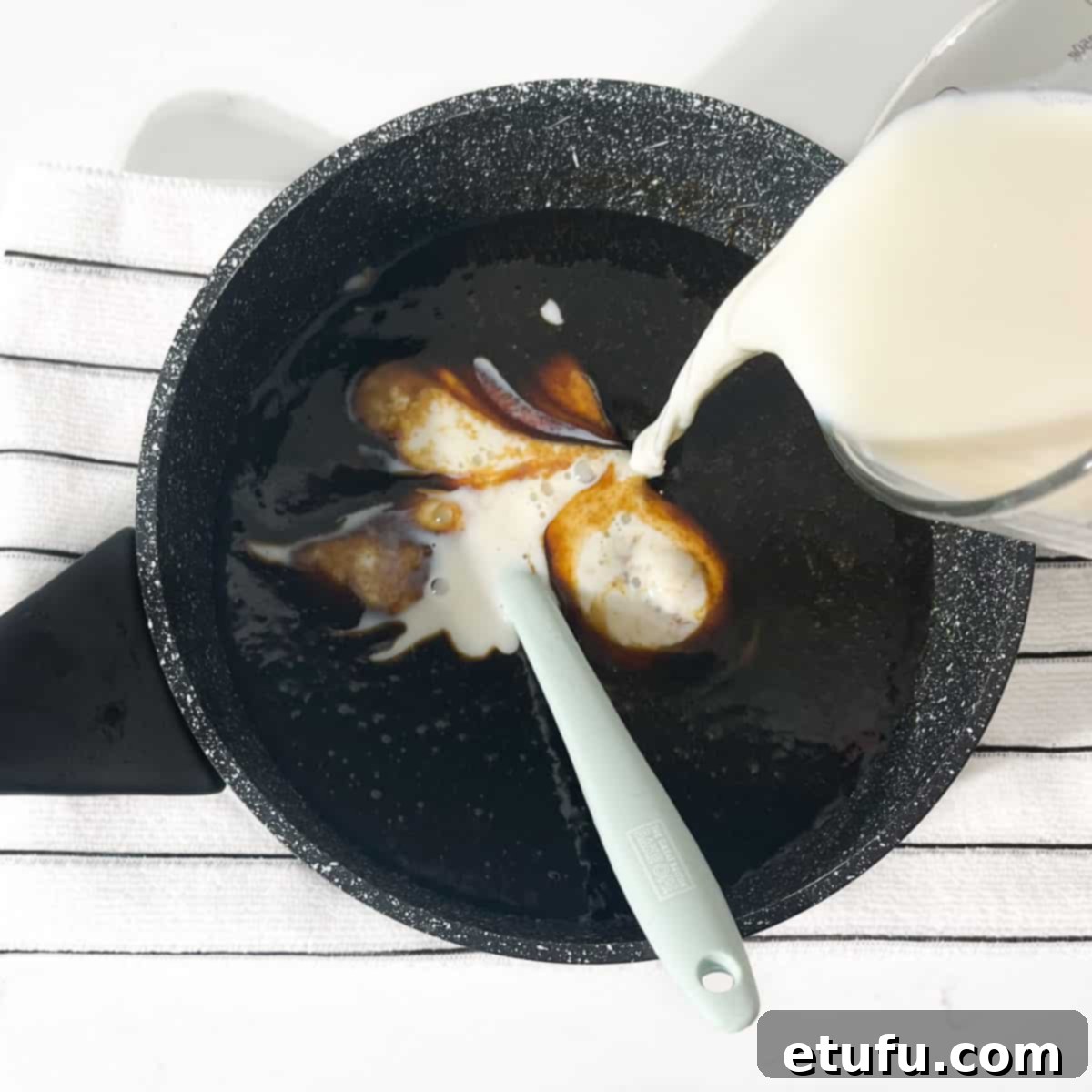
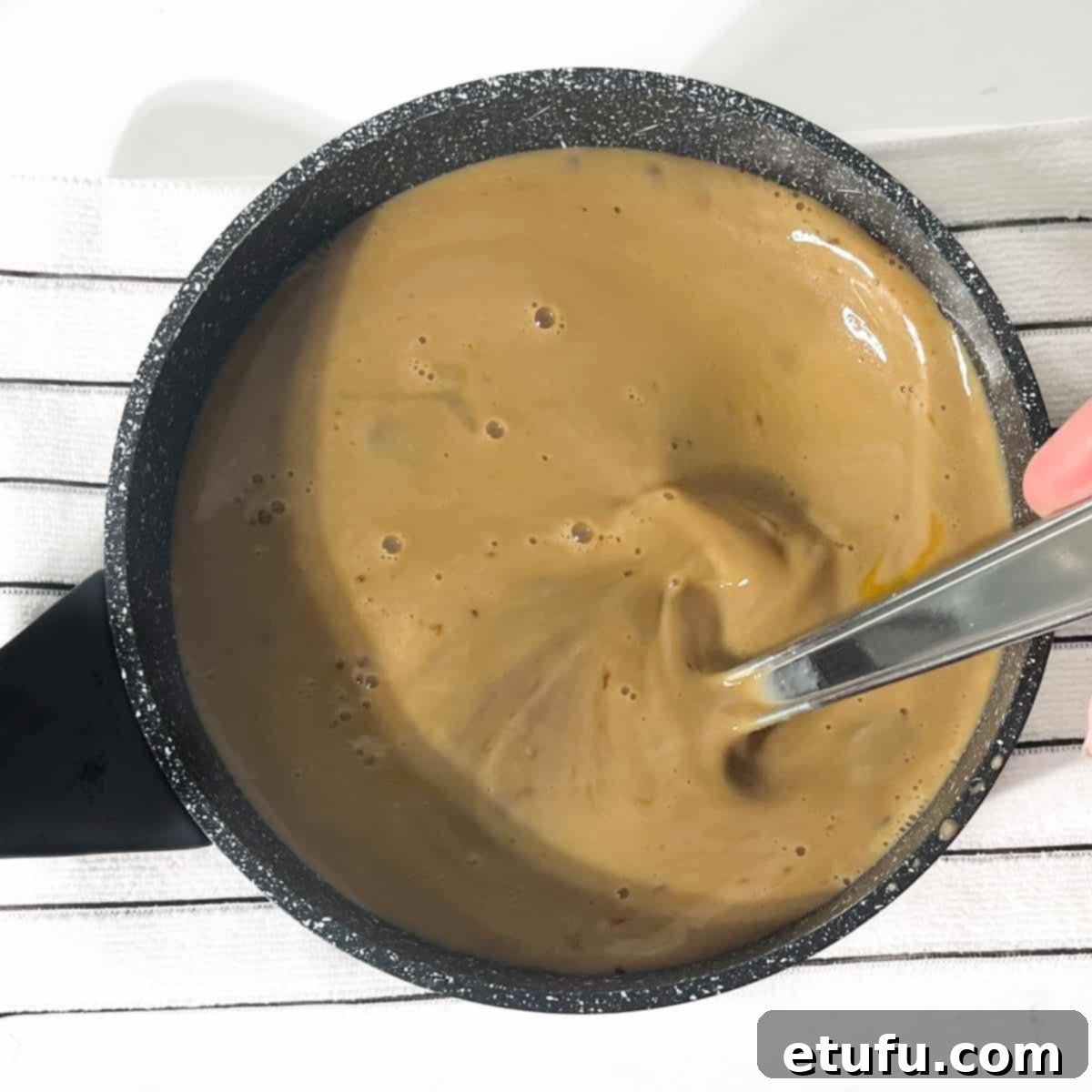
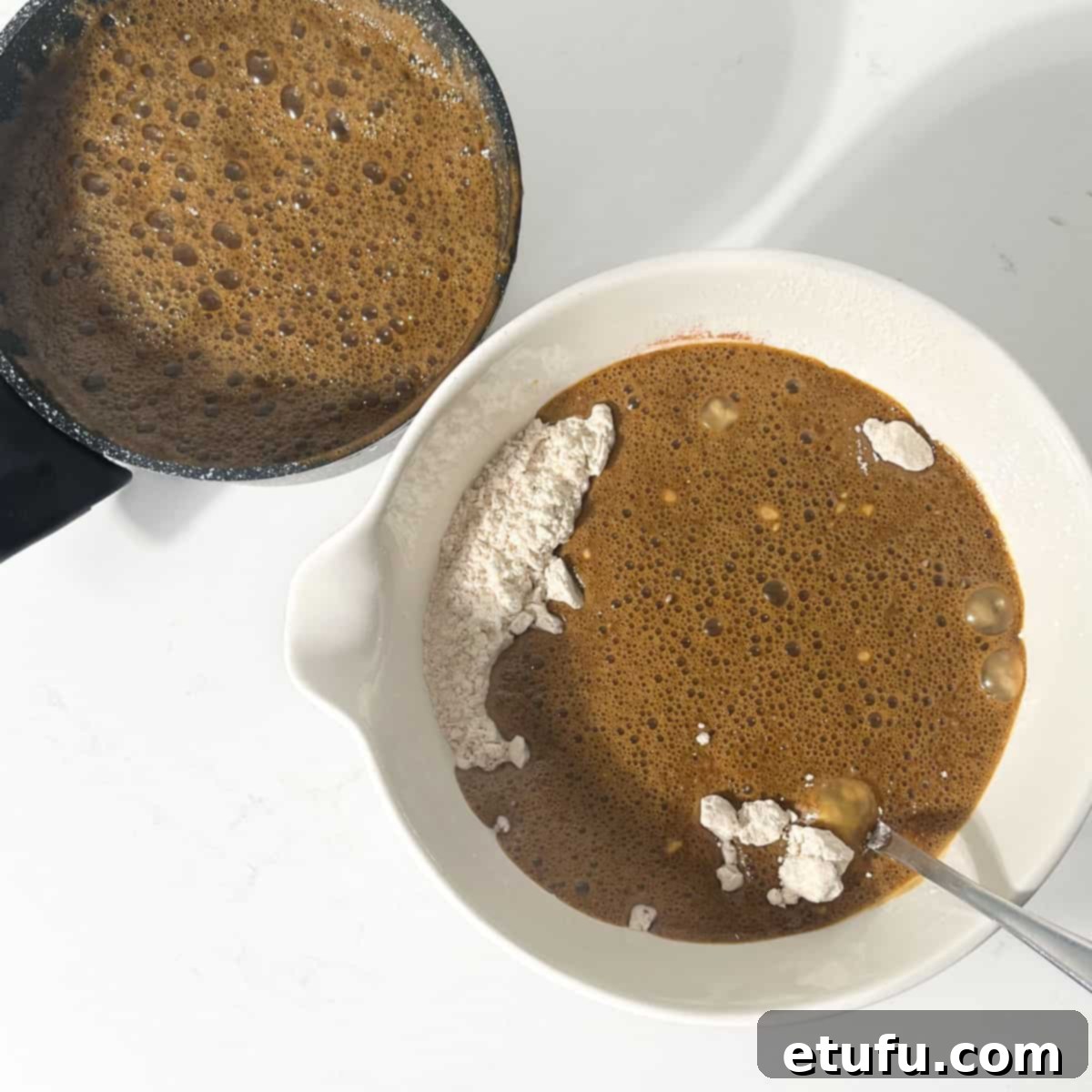
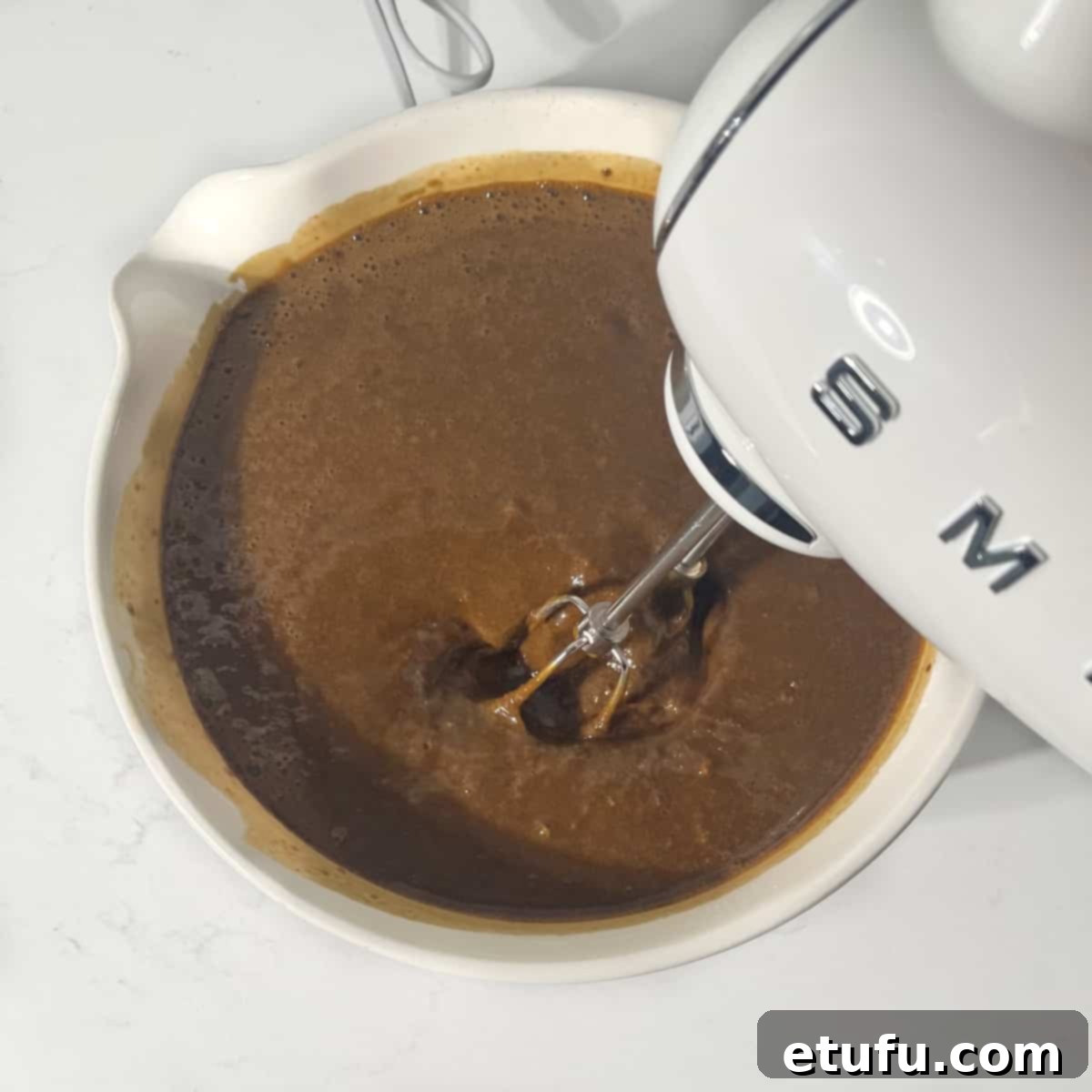
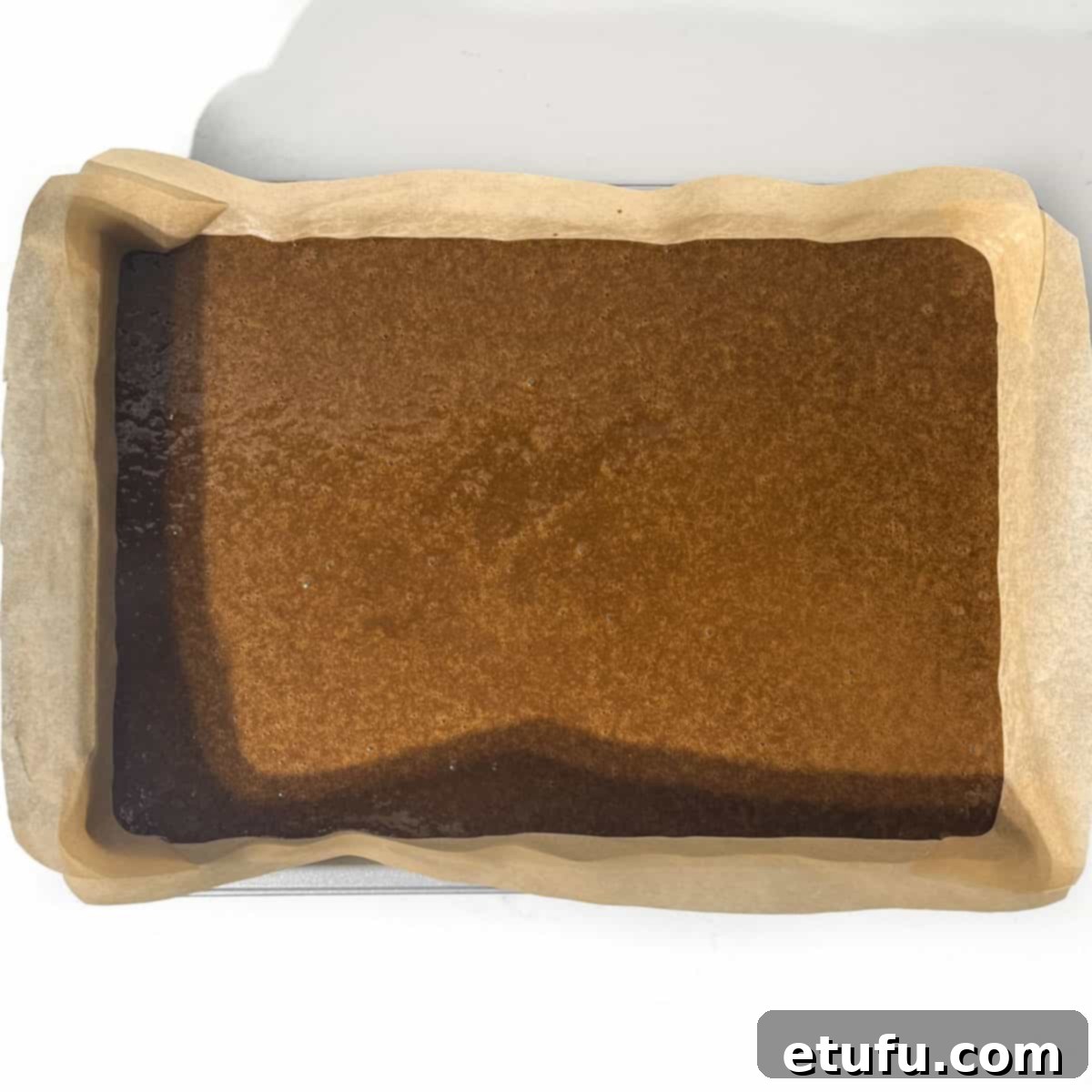
Exciting Variations for Your Jamaican Ginger Cake
While the classic Jamaican Ginger Cake is perfect on its own, it also serves as a fantastic canvas for creative adaptations. Feel free to experiment with these variations to add your own personal touch:
- Citrus Zest Infusion: Introduce a bright, zesty counterpoint by adding a dash of finely grated lemon or orange zest to the batter. The citrus notes beautifully complement the warming spices.
- Nutty Crunch: For added texture and a rich, earthy flavor, mix in a handful of chopped nuts such as walnuts, pecans, or even almonds. They provide a delightful contrast to the cake’s soft, moist crumb.
- Dried Fruit Delight: Incorporate plump dried fruits like raisins, currants, or finely chopped dates. These add pockets of chewy sweetness and extra moisture, reminiscent of a traditional fruit cake.
- A Grown-Up Twist with Liqueur: For an adult-friendly version, add a splash (1-2 tablespoons) of dark rum, brandy, or even a ginger liqueur to the wet ingredients. This imparts a sophisticated depth of flavor.
- Sweet Ginger Glaze: Elevate the visual appeal and add another layer of ginger flavor by drizzling a simple ginger glaze over the cooled cake. Combine icing sugar with a small amount of the syrup from preserved stem ginger (or a tiny splash of fresh ginger juice) until you reach a pourable consistency.
- Spice Exploration: Don’t be afraid to experiment with other spices. A pinch of ground cardamom can add an exotic fragrant note, or for those who crave a fiery kick, a tiny dash of cayenne pepper can provide a surprising warmth.
Expert Top Tips for the Perfect Ginger Cake
Achieving a truly exceptional Jamaican Ginger Cake is easier with a few expert tips. These insights will help you avoid common baking pitfalls and ensure your cake is consistently perfect, moist, and flavorful.
Prioritize Precision: Use a Digital Scale and Quality Measuring Spoons
Baking is a science, and accuracy is paramount. While volume measurements (cups and spoons) can suffice, investing in a reliable digital kitchen scale is a game-changer for precise ingredient measurements, especially for flour, sugar, and syrups. High-quality measuring spoons also ensure consistent amounts of your potent spices. Accuracy plays an undeniably crucial role in achieving cake perfection, impacting everything from texture to taste.
The Importance of Room Temperature Eggs
Never underestimate the power of room temperature eggs! Remember to allow fridge-cold eggs to reach room temperature before you begin baking. Cold eggs, when added to a batter, can cause butter to seize and create a lumpy mixture, preventing smooth emulsification. Room-temperature eggs, on the other hand, blend seamlessly into the batter, creating a lighter, more uniform texture and contributing significantly to the creation of tender, evenly rising cakes. You can easily achieve this by removing your eggs from the fridge about 30 minutes beforehand, or for a quicker solution, by placing them in a bowl of warm (not hot) water for about 5 minutes.
Mastering the Bicarbonate of Soda Addition
Bicarbonate of soda (baking soda) is a powerful leavening agent. When adding it to your wet ingredients, sprinkle it gently and evenly across the surface while continuously whisking. This technique is vital to prevent the bicarbonate of soda from clumping together, which can result in pockets of bitter taste or uneven rising. If, despite your best efforts, you do end up with a few stubborn clumps in the mixture, a stick blender can come to your rescue. Simply immerse it and blend specifically around the clumps until they are fully incorporated and the mixture is smooth.
Finely Chop Stem Ginger (If Using)
If you’re enhancing your recipe with stem ginger, the key to its successful inclusion is fine chopping. Chop the stem ginger into very small, minced pieces. This helps significantly in preventing the chunks from sinking to the bottom of the wet cake batter during baking. Since the batter for this Jamaican ginger cake is quite thin and pourable, solid, heavier pieces like stem ginger have a natural tendency to settle at the base as the cake bakes. Smaller and lighter ginger pieces are far less likely to sink through the thin batter, ensuring a more even distribution throughout the cake. Additionally, after finely chopping the stem ginger, toss the pieces in a tablespoon of the dry flour mixture. This light coating helps to suspend them more effectively within the batter.
Understand Your Oven: Your Best Baking Ally
Every oven has its unique personality. Get to know your oven’s quirks: does it run hotter or cooler than the set temperature? Does it have hot spots? If you observe such tendencies, be prepared to adjust your bake times and temperatures accordingly. Trust your instincts and perform visual tests: look for a springy top when gently pressed and use a thin cake tester or skewer (inserted into the center) as an indicator of doneness (it should come out clean). When in doubt, especially with a new recipe or oven, it is always safer to bake for a slightly longer period at a slightly lower temperature, within reason, rather than risk an underbaked or burnt cake. Always check the cake for doneness at the lowest recommended cooking time and extend only as necessary.
Delightful Serving Suggestions for Your Ginger Cake
This versatile Jamaican Ginger Cake can be enjoyed in many ways, from a simple afternoon treat to a decadent dessert. Here are some serving suggestions to elevate your experience:
- Freshly Whipped Cream: A generous dollop of lightly sweetened, freshly whipped cream offers a cool, creamy contrast that beautifully balances the cake’s warm spiciness.
- Vanilla Ice Cream: Serve warm slices of ginger cake with a scoop of high-quality vanilla bean ice cream. The melting ice cream creates a delightful sauce and a luxurious mouthfeel.
- Tangy Mascarpone Cream: For a hint of sophisticated tang that perfectly complements the cake’s sweetness, dollop some homemade mascarpone cream on top. Its rich, slightly tart profile adds another dimension.
- Indulgent Caramel Sauce: Drizzle a warm, luscious caramel sauce over slices of ginger cake. This creates an incredibly decadent treat, adding a sticky, sweet layer.
- Bright Fresh Berries: A handful of vibrant fresh berries, such as sweet strawberries or tart raspberries, provides a refreshing, fruity element that cuts through the richness of the cake.
- Crunchy Chopped Nuts: Sprinkle some toasted chopped nuts – pecans, walnuts, or even pistachios – over the cake just before serving. They add a pleasing textural contrast and nutty flavor.
- Classic Hot Custard: For the ultimate British comfort, serve warm slices of ginger cake with a generous side of homemade hot custard. This is a truly comforting and traditional pairing.
- Perfect with Tea: Pair a slice of this warming cake with a hot cup of black tea for a quintessential British afternoon snack. The tea complements the spices without overpowering them.
- Bold Coffee Companion: Enjoy a slice with a strong cup of coffee. The robust flavors of the coffee stand up well to the cake’s spiciness, creating a satisfying pairing.
- Garnish with Citrus Zest: A final flourish of grated orange or lemon zest over each slice adds a lovely aroma and a subtle citrusy twist that brightens the cake’s rich flavors.
Storage Guidelines for Optimal Freshness
One of the remarkable qualities of Jamaican Ginger Cake is its ability to improve with age. The flavors deepen and meld beautifully, making it arguably even better on the second or third day after baking. Proper storage ensures you can enjoy its perfection for longer.
Store the cooled cake in an airtight container at room temperature. Kept away from direct sunlight, heat sources, and excessive moisture, it will remain wonderfully moist and flavorful for up to 4 days. Avoid refrigeration, as this can dry out the cake and diminish its texture.
For extended storage, this ginger cake freezes exceptionally well. Once completely cooled, wrap the entire cake (or individual slices) tightly in plastic wrap, ensuring it’s sealed to prevent freezer burn. Follow this with a layer of aluminum foil for added protection. The cake can be frozen for up to 3 months without compromising its quality.
To enjoy a frozen cake, simply thaw it slowly in the refrigerator overnight. Once thawed, it can be brought to room temperature before serving for the best texture and flavor.
More Warming and Spicy Bakes to Explore
If you’ve fallen in love with the comforting spices of this Jamaican Ginger Cake, you’ll surely enjoy these other aromatic bakes:
- Spice Biscuits (Soetkoekies)
- Tunisian Orange and Almond Cake
- Sultana Loaf
- White Chocolate and Stem Ginger Cheesecake
- Spiced Apple Cake
- Eve’s Pudding with Spices and Caramelised Apples
Sticky Jamaican Ginger Cake Recipe
This indulgent Jamaican ginger cake is not only incredibly easy to make but also possesses the remarkable quality of improving with time. It’s dark, sticky, moist, warming, and oh-so-comforting, making it a truly unforgettable British classic.
Course: Dessert, Snack
Cuisine: British
Prep Time: 10 minutes
Cook Time: 50 minutes
Total Time: 1 hour
Servings: 24 slices
Calories: 274 kcal per serving
Author: Maretha Corbett
Equipment
- 1 rectangular baking tin, approximately 33cm x 23cm
- A balloon whisk (and an electric hand whisk, optional)
- A couple of mixing bowls
- A medium-large saucepan
Ingredients
- 450 grams plain flour
- 2½ tablespoons ground ginger (can increase to 3 for a warmer cake)
- 1 teaspoon ground cinnamon
- 1 teaspoon allspice
- ½ teaspoon ground nutmeg
- ⅛ teaspoon ground cloves
- 220 grams butter (if using unsalted butter, add ½ teaspoon salt to the flour mixture – optional)
- 190 grams dark brown sugar
- 300 grams golden syrup
- 300 grams black treacle
- 375 millilitres milk (or 388g if weighing)
- 3 large eggs (at room temperature)
- 1 tablespoon bicarbonate of soda
- 100 grams stem ginger (optional, or 6 pieces from an Opies jar), finely chopped
Instructions
Prepping
- Preheat the oven to 170°C/338°F/gas mark 3. Line a rectangular baking tin measuring approximately 33cm x 23cm with baking paper.
- If using stem ginger, finely chop it with a sharp knife and set it aside.
- In a large mixing bowl, sieve the plain flour along with the ground ginger, ground cinnamon, allspice, ground nutmeg, and ground cloves.
- Crack the eggs into a separate bowl and give them a quick whisk to break them up.
Make the Cake
- Add the butter, dark brown sugar, golden syrup, and black treacle to a saucepan.
- Over a low, gentle heat, melt all the ingredients together. Do not bring to a boil; simply heat enough to melt the butter and combine the ingredients.
- Begin by adding the milk first to temper the hot liquid, then incorporate the whisked eggs and bicarbonate of soda. When adding the bicarbonate of soda, sprinkle it evenly over the surface while whisking to prevent clumping. Thoroughly whisk the mixture to ensure everything is well combined.
- Gradually add the wet ingredients to the dry flour mixture, mixing thoroughly after each addition until a wet, pourable batter is formed.
- Give the batter a final whisk using an electric hand mixer on medium speed, or vigorously by hand. If using stem ginger, add it now and gently fold it in. Please note that stem ginger may sink somewhat to the bottom, even if coated in flour. It’s still a delicious addition!
- Pour the batter into the prepared baking tin and place it on the middle shelf of the preheated oven. Bake for 50-55 minutes, or until the cake starts to pull away slightly from the sides and the middle feels firm yet springy to the touch.
- Allow the cake to cool in the baking tin for 30 minutes before carefully turning it out onto a wire cooling rack to cool completely.
- Slice the cake into squares and enjoy it with a robust cup of coffee or tea.
Recipe Notes & Expert Tips
- Use a Scale for Accuracy: For precise ingredient measurements, particularly for flour and sugar, consider using a reliable digital kitchen scale. Accuracy is key to achieving consistent cake perfection.
- Room Temperature Eggs: Always allow fridge-cold eggs to reach room temperature before baking. This helps them blend smoothly into the batter, contributing to a tender and evenly risen cake.
- Adding Bicarbonate of Soda: Sprinkle bicarbonate of soda gently and evenly over the wet ingredients while whisking to prevent clumps. If clumps form, a stick blender can help disperse them.
- Finely Chop Stem Ginger: If adding stem ginger, chop it into very fine pieces and toss them in a little flour. This minimizes sinking in the thin batter and ensures a better distribution.
- Know Your Oven: Understand your oven’s specific heating patterns. Adjust baking times and temperatures if your oven runs hot or cold. Always check for doneness at the minimum recommended time using visual cues and a cake tester.
Nutritional Data Disclaimer
Please be aware that the nutritional information provided below is calculated by a third party, and its accuracy cannot be guaranteed. We strive to offer the most precise information, but we do not take responsibility for potential errors. The nutritional value of this recipe may also vary based on the exact brands and products used. We recommend consulting a qualified healthcare professional or registered dietitian for personalized advice regarding your dietary needs.
Nutrition Per Serving
Calories: 274 kcal | Carbohydrates: 45g | Protein: 4g | Fat: 9g | Saturated Fat: 5g | Polyunsaturated Fat: 0.5g | Monounsaturated Fat: 2g | Trans Fat: 0.3g | Cholesterol: 42mg | Sodium: 215mg | Potassium: 261mg | Fiber: 1g | Sugar: 30g | Vitamin A: 286 IU | Vitamin C: 0.04mg | Calcium: 99mg | Iron: 3mg
For essential food safety advice, including comprehensive guidance on food allergies, please refer to official guidelines.
More Delicious Snacks On-the-Go
Looking for more convenient and delightful treats? Explore these easy-to-pack and perfect-for-travel snack recipes:
- Buttermilk Blueberry Muffins
- Fudgy Triple Chocolate Muffins
- Lemonade Scones
- Raspberry and White Chocolate Blondies
- The Best Sultana Cake Recipe
- Banana Chocolate Chunk Muffins
- Easy Date Squares with Coconut
- Chocolate Tiffin (No-Bake Scottish Fridge Cake)
- Our Favorite 4-Ingredient Banana Bread
Discover More Sweet Treats from the United Kingdom
If you’re enjoying this taste of British baking, delve deeper into the UK’s rich dessert traditions with these other beloved sweet treats:
- Classic Gypsy Creams (Crunchy Oat Biscuits)
- Chocolate Tiffin (A Scottish No-Bake Delight)
- Eve’s Pudding with Spices and Caramelised Apples
- Festive Sherry Trifle (A Quintessential English Dessert)
- Easy Fruity Flapjacks
